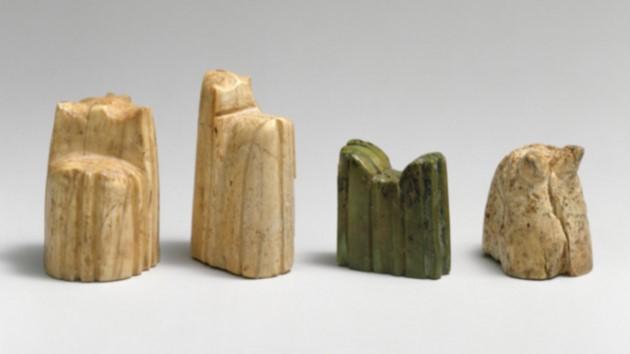
Shatranj Tabbiyat
When I was a young kid, I often would set up "battle positions" for my toy soldiers without actually ever engaging in conflict. The ancient Persian game of shatranj was a lot like this, where players would not engage in "first blood" until the desired tabbiyya was reached.
Tabbiyya or plural Tabbiyat is a term chess players may be familiar with. In Arabic, it means "Battle Array", so when, as an adult, I found out that my true love for chess may be deeper than I thought, I began a quest.
I was searching for a piece of history. Like the absent pawn in the above game, a mysterious air began to envelop my every chess move until I could play no longer. I thought to myself, "I must find out more about the roots of chess and its history after migrating from India along the Silk Road to Persia."
The clues were few and far between. Google image searches for shatranj (or chatranj) revealed pieces that looked like modern abstract art in beautiful turquoise or green colors. Libraries had nothing. Wikipedia had an article with quite a bit of entry-level information such as piece movements and English translations for the various shatranj terminology written from Arabic sources.
Then one October 11, 2013, a stroke of luck happened. I was frustrated and fatigued from hours of internet searches, when I came across a Wikipedia article in what appeared to be a Chinese script.
This did not defray me, and after sifting through page upon page of diagrams my jaw dropped open, and I hit "CTRL+P" (print) as quickly as possible. I found that the shatranj article came complete with 16 listed tabbiyyat as I collected the 10 fresh, warm pages from the printer tray.
I began to get so excited, it was as if for a moment, I had recovered a piece of my childhood, the tabbiyyat of olden days and toys. A moment of shock struck me, and I ran to Chess.com to join the live server. I laid the pages next to my keyboard, and smiled as tears of joy quelled in my eyes.

"I wonder if I can reach these positions in a chess game," I thought. I played several games, losing them all, straining my mental capacities to achieve a full battle array from one of the diagrams printed, when I knew very well that the piece movements differed from the ancient game to the modern one we play today.
Nevertheless, I was successful in achieving one of the positions, and smiled a sweet sigh of relief, when in classic "Kinglybingly" fashion, I let my time expire on the board while I snapped a screenshot and moved my work over to Microsoft Paint.
That holiday, I asked for a shatranj set. No one in my family knew what I meant, and even when I explained it, they passed off the thought as ludicrous. When we opened presents, I got a beautiful miniature glass chess set. I smiled but all the while on the inside my soul was in torment.
"No one understands me," I thought.
I went back to my room and found the printed tabbiya diagrams, folding them in half and slipping them into Bruce Pandolfini's Chess Traps and Zaps, Vol. 2. Life happened, and I moved several times, forgetting all about my investigation into the history of chess.
Then, just last week, almost 5 years later, I played a game on the live server in which the word Mujannah appeared in a variation of the Bird (A03 ECO). I recognized this immediately as having roots with the ancient Persian variation of chess, and the flame was rekindled. Below is an example of this position reached after 1.c4 Nf6 2. f4 (I blundered the game, but you get the idea from the opening):
Today, I wanted to share this sacred part of my chess story with you and present the 16 positions found, in hopes that it will inspire your life in some sort of way.
Author Note: If you have not already done so, please read the photo credit article from The MET (Metropolitan Museum of Art in New York). The associate curator from the Department of Islamic Art is a native to Iran and wrote a fantastic piece. She concludes the article with this poem from the 11th century:
'Tis all a Chequer-board of Nights and Days
Where Destiny with Men for Pieces plays:
Hither and thither moves, and mates and slays,
And one by one back in the closet lays.
Tabbiyat:
1. Watad al'anz
2. Muraddad
3. Hisa fir'auna
4. 'Aja'iz
5. Mujannah
8. Mu'aqrab
12. Raqu'iqi
13. 'Ibt
14. Kirmani
15. Muwashshah
16. Mutalahiq
